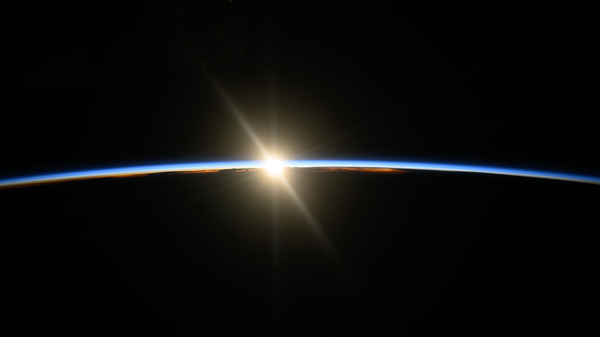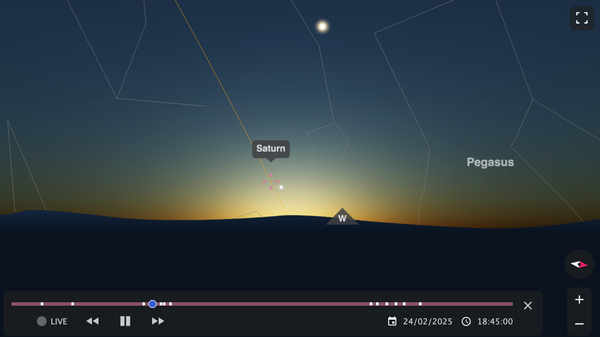Planet Parade 2025: Can We See All the Planets?
We were curious: How often are all the planets above the horizon at the same time, in a darkish sky?

The Sun lights up Earth’s atmosphere in this view from the International Space Station. For the sky to be dark, the Sun has to be a certain distance below the horizon.
©NASA/Matthew Dominick
Mercury Joins Parade, Saturn Leaves
The start of 2025 has been a spectacular time to see the planets. Venus, Mars, Jupiter, and Saturn have been easy to spot with the naked eye, while Uranus and Neptune have been well positioned for observers with binoculars or a telescope. Many have been calling it a planet parade.
Find the planets on our Night Sky MapToward the end of February, Mercury joins the parade. Orbiting close to the Sun, Mercury can be tricky to spot: it will appear in the evening twilight, close to the point on the horizon where the Sun sets.
However, in the same part of the sky, as Mercury joins the planetary line-up, Saturn leaves. The ringed planet is edging closer to the Sun, and becoming more hidden in the Sun’s bright glare.


Venus dazzles in the upper half of this view from our Night Sky Map for Miami, USA, at 18:45 (6:45 pm) local time on February 24. Higher up in the sky (not shown here), Mars and Jupiter also shine brightly. However, Saturn (marked with crosshairs) and Mercury (just to the right of Saturn) are close to the horizon, and more difficult to see.
©timeanddate.com
All the Planets, Plus a Dark Sky?
Overall, it will not be easy to see all the planets in the sky at the same time. Here at timeanddate.com, this got us thinking: How often are all the planets above the horizon at the same time, in a reasonably dark sky?
The answer is: Not very often, and then only for a certain area of the globe. But there are a few days this month when this rare alignment of the Sun and the planets takes place.
Defining a Dark Sky
We set the following conditions for a dark-sky planet parade. We looked for periods when, from some location in the world:
- The Sun is 6 degrees or more below the horizon, and
- Every planet (including Uranus and Neptune) is 6 degrees or more above the horizon.
Why do we want the Sun to be at least 6 degrees below the horizon? As we all know, the sky doesn’t immediately get dark when the Sun sets. Instead, we enter a period of civil twilight, where the sky remains lit up, and only the brightest planets and stars can be seen.
Civil twilight continues until the Sun has reached a point 6 degrees below the horizon: this is the start of nautical twilight. The sky is still not completely dark—the horizon is still visible—but more planets and stars can now be seen.
And why do we want the planets to be a certain distance above the horizon? If a planet is too close to the horizon, it is difficult or impossible to see. We can’t “look up” to see the planet—instead, we have to look in a more horizontal direction. This means we have to look through more of Earth’s atmosphere, making the planet dimmer, or even invisible.
In addition, objects close to the horizon are often blocked by hills, buildings, and other obstacles. There are no firm rules about this: we picked 6 degrees as a convenient lower limit for the planets, but we could have chosen a different value.
For a Few Days Only
The above conditions for a dark-sky planet parade will be met for a few days this month, around February 23–26, within a certain band of latitudes.
For example, on the evening of February 24, all the planets will be at least 6° above the horizon—with the Sun at least 6° below the horizon—for locations at latitudes between 3°S and 42°N.
Let’s take the city of Miami, USA, which is in the middle of this zone—it lies at a latitude of 26°N. The table below shows the altitudes of the Sun and the planets, as seen from Miami at 18:45 (6:45 pm) local time on February 24.
You can click on the planet name in the table to show its position on our Night Sky Map.
Planet Parade in a Dark Sky
Where is the Moon in all this? New Moon falls on February 27 or February 28, depending on your time zone. This means that, around February 24, the Moon is a Waning Crescent that sets during the afternoon.
A Handful of Occasions per Century
How unusual is it to have a period where these dark-sky planet parade conditions are met for certain locations on Earth? It only happens on a handful of occasions per century.
According to our calculations, the next period will be in 2036, around March 31–April 1. The next window after that will be in 2060, around November 13–17.
To recap, we picked these conditions to strike a balance between having a darkish sky without the planets being extremely close to the horizon. Nevertheless, even when the Sun is at an altitude of -6°, the sky may still be too bright to catch a faint planet at an altitude of 6° in the same direction.
Mind-Boggling Problem
“Searching for times when all the planets are above the horizon somewhere on Earth was a surprisingly tricky problem,” says timeanddate.com’s Frank Tveter, who has a doctorate in celestial mechanics.
“Interpreting the results was even more mind-boggling. Without the strict rule about twilight, the computer found many cases where all the planets are visible on the horizon from a single location at the top or bottom of the globe.
“These cases are interesting, but often impractical—they rely on extreme conditions where the Sun interferes with the planets’ visibility.”
To sum up: it’s never easy to see all the planets at the same time. Regardless, the 2025 planet parade has been spectacular—and you can still catch it for a couple of weeks yet.